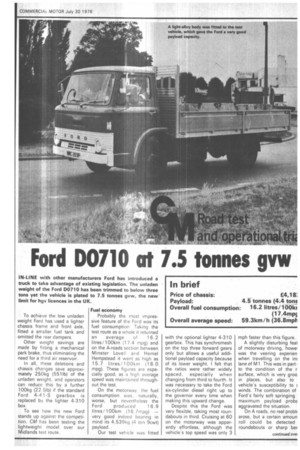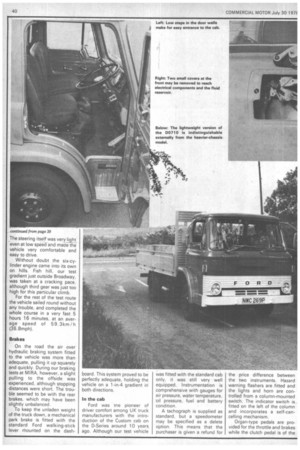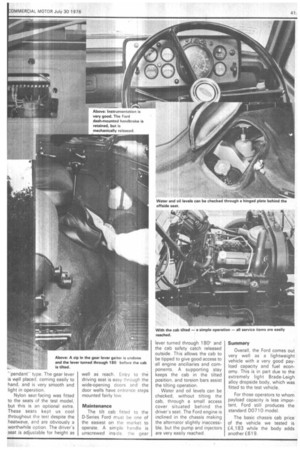Ford D0710 at 7.5 tonnes giro,
Page 41

Page 42

Page 43

If you've noticed an error in this article please click here to report it so we can fix it.
IN-LINE with other manufacturers Ford has introduced a truck to take advantage of existing legislation. The unladen weight of the Ford D0710 has been trimmed to below three tons yet the vehicle is plated to 7.5 tonnes gvw, the new limit for hgv licences in the UK.
To achieve the low unladen weight Ford has used a lighter chassis frame and front axle, fitted a smaller fuel tank and omitted the rear dampers.
Other weight savings are made by fitting a mechanical park brake, thus eliminating the need for a third air reservoir.
In all, these deletions and chassis changes save approximately 250kg (5511b) of the unladen weight, and operators can reduce this by a further 100kg (22 51b) if the standard Ford 4-41-S gearbox is replaced by the lighter 4-310 box.
To see how the new Ford stands up against the competition, CM has been testing the lightweight model over our Midlands test route. Fuel economy Probably the most impressive feature of the Ford was its fuel consumption. Taking the test route as a whole it returned an average of 1 6. 2 litres/100km (17.4 mpg) and on the A-roads section between Minster Lovell and Hemel Hempstead it went as high as 15.7 litres/ 100km (18.0. mpg). These figures are especially good, as a high average speed was maintained throughout the test.
On the motorway, the fuel consumption was, naturally, worse, but nevertheless the Ford produced 16.9 litres 100km (16.7mpg) -very good indeed bearing in mind its 4,539kg (4 ton 9cwt) payload.
Our test vehicle was fitted with the optional lighter 4-310 gearbox. This has synchromesh on the top three forward gears only but allows a useful additional payload capacity because of its lower weight. I felt that the ratios were rather widely spaced, especially when changing from third to fourth. It was necessary to take the Ford six-cylinder diesel right up to the governor every time when making this upward change.
Despite this the Ford was very flexible, taking most roundabouts in third. Cruising at 60 on the motorway was apparently effortless, although the vehicle's top speed was only 3 mph faster than this figure.
A slightly disturbing feat of motorway driving, howe, was the veering experien when travelling on the in lane of Ml. This was in part ; to the condition of the r surface, which is very groo in places, but also to vehicle's susceptibility to E winds. The combination of Ford's fairly soft springing maximum payload probE aggravated the situation.
On A roads, no real probk arose, but a certain arnoun roll could be detected roundabouts or sharp ber
The steering itself was very light even at low speed and made the vehicle very comfortable and easy to drive.
Without doubt the six-cylinder engine came into its own on hills. Fish hill, our test gradient just outside Broadway, was taken at a cracking pace, although third gear was just too high for this particular climb.
For the rest of the test route the vehicle sailed round without any trouble, and completed the whole course in a very fast 5 hours 16 minutes, at an average speed of 59.3km /h (36.8mph).
Brakes On the road the air over hydraulic braking system fitted to the vehicle was more than adequate, pulling it up squarely and quickly_ During our braking tests at MIRA, however, a slight pulling to the offside was experienced, although stopping distances were short. The trouble seemed to be with the rear brakes, which may have been slightly unbalanced.
To keep the unladen weight of the truck down, a mechanical park brake is fitted with the standard Ford walking-stick lever mounted on the dash board. This system proved to be perfectly adequate, holding the vehicle on a 1-in-4 gradient in both directions.
In the cab Ford was toe pioneer of driver comfort among UK truck manufacturers with the introduction of the Custom cab on the D-Series around 10 years ago. Although our test vehicle was fitted with the standard cab only, it was still very well equipped. Instrumentation is comprehensive with gauges for air pressure, water temperature, oil pressure, fuel and battery condition.
A tachograph is supplied as standard, but a speedometer may be specified as a delete option. This means that the purchaser is given a refund for the price difference between the two instruments. Hazard warning flashers are fitted and the lights and horn are controlled from a column-mounted switch. The indicator switch is fitted on the left of the column and incorporates a self-cancelling mechanism.
Organ-type pedals are provided for the throttle and brakes while the clutch pedal is of the "pendant" type. The gear lever is well placed, coming easily to hand, and is very smooth and light in operation.
Nylon seat-facing was fitted to the seats of the test model, but this is an optional extra. These seats kept us cool throughout the test despite the heatwav.e, and are obviously a worthwhile option. The driver's seat is adjustable for height as well as reach. Entry to the driving seat is easy through the wide-opening doors and the door wells have entrance steps mounted fairly low Maintenance The tilt cab fitted to the D-Series Ford must be one of the easiest on the market to operate. A simple handle is unscrewed inside, the gear lever turned through 180° and the cab safety catch released outside. This allows the cab to be tipped to give good access to all engine anciliaries and components. A supporting stay keeps the cab in the tilted position, and torsion bars assist the tilting operation.
Water and oil levels can be checked, without tilting the cab, through a small access cover situated behind the driver's seat. The Ford engine is inclined in the chassis making the alternator slightly inaccessible, but the pump and injectors are very easily reached.




















































































